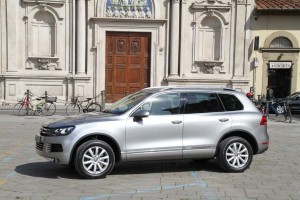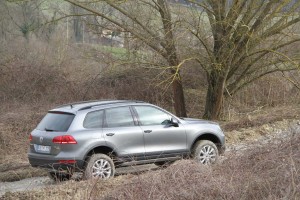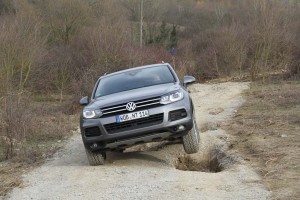
With its gas-electric drivetrain, the 2011 Volkswagen Touareg Hybrid delivers V8 performance and promises V6 mileage.
The streets of the old city are crowded, tourists gaping at the sights as they wander down the middle of the narrow streets of Florence at first not even noticing our big SUV rolling by. That’s easy to do when it’s running in near-silent battery mode, the only sounds the crunching of tires on the pavement and the subtle hum of the 2011 Volkswagen Touareg’s electric motor.
It’s been a decade since the first hybrid-electric vehicles began rolling into showrooms. Until recently, the field was dominated by Asian makers, Toyota in particular, with the popular Prius. After a slow start, U.S. makers have steadily ramped up their own menu of gas-electric offerings, but until recently, Europen marques seemed determined to prove to the world they had a better solution in the form of the diesel drivetrain.
Suddenly, that’s shifting. The new decade is bringing with it a wave of hybrid entries from German marques like Mercedes-Benz, BMW and, for the upcoming model-year, VW, which enters the alternative power fray with the completely-redesigned Touareg, which will be offered, starting in 2011, with a broad mix of powertrain options, including conventional gasoline, diesel and hybrid.

VW has shaved 400 pounds off the second-generation Touareg, adding a variety of new features -- though many won't make it to the U.S.
The timing echoes the launch of VW’s original sport-utility vehicle. The first-generation Touareg was also late to the field, reaching market only in 2002, arguably after the peak of America’s light truck boom. The ‘02 Touareg had a number of things going for it, including a beautifully-executed interior and a truly go-anywhere drivetrain that could handle even the likes of Moab, site of some of the toughest off-road trails you can find.
But the big ute was heavy and expensive, and fuel economy was certainly not something VW marketers could boast about – not until the introduction of a downsized V6 diesel, a few years back.
With the 2011 redesign, Volkswagen planners aimed to overcome much of the criticism – though that did involve a few trade-offs. The second-generation SUV is still reasonably capable, off-road, though we’d now be a little more reluctant to use it to tackle Moab’s harsher trails. But the ’11 Touareg’s on-road manners – as well as its fuel economy – have notably improved because, among other things, VW engineers have found ways to shave about 400 pounds from the bulk of the hefty original.
But the real news is the introduction of the first Volkswagen gas-electric drivetrain. This is a full hybrid, in line with the Prius or Ford’s Escape Hybrid, meaning the new VW entry can run solely on electric propulsion, for brief periods, or use its battery power to help accelerate.
The electric side of the powertrain, it turns out, is the same – minus some software tweaks – that’s also making its debut on the second-generation Porsche Cayenne. Fans will recall that the two makers cooperated on their original SUVs, and that partnership continued with the development of the updated 2011 SUVs. They also cooperated on their hybrid technology.
“There’s a slight (change) in terms of software, but otherwise it’s a common system,” explains VW’s Christine Buhlmann.
In technical terms, it’s a parallel hybrid, meaning the 2011 Volkswagen Touareg (or Porsche Cayenne) can run off either gasoline or battery power or use both simultaneously. VW officials boast that this results in V8 performance with 6-cylinder fuel efficiency
The internal combustion side of the package is a 333-horsepower V6, which is paired with a 47-hp electric motor, which links into the driveline through a unique clutch of its own. The transmission is a new eight-gear assembly.
Under normal driving conditions, the 2011 VW Touareg will start off in electric mode and as long as you’re not hard on the throttle, stay on battery power up to about 32 mph – for roughly 1.5 miles or until the nickel-metal hydride pack is drained. (On the highway, while coasting, the engine will go to idle at speeds up to 99 mph.)
Driving through the streets of Florence we found the hybrid drive system smooth and efficient, switching between gas, electric and dual power almost imperceptibly. The 2011 VW Touareg Hybrid also features a Start/Stop system, which engineers claim can improve fuel efficiency by up to 5% by briefly shutting off the IC engine when you’re idling, then automatically starting back up when you lift your foot off the brake. Again, that happens almost transparently.
Our one complaint – and it isn’t a minor one – concerns the brakes on the Touareg Hybrid. As with any gas-electric vehicle, they’re a compound system that incorporates both conventional hydraulic braking, and a regenerative system that, under most conditions, converts kinetic energy into electricity. That’s how the batteries get recharged.
Unfortunately, the regen brakes proved extremely grabby, primarily at the sort of speeds you’ll experience on city streets. Step down on the pedal the same way you would in a standard-issue Touareg and you’ll be lurching forward in your seat. Yes, you can modulate the brakes once you feel them out, but it takes time to get used to their idiosyncratic nature and, frankly, you shouldn’t have to work that hard. Hearing the same complaint from others who’ve driven the 2011 Touareg Hybrid, we’re hoping the automaker will be able to tweak the system before it reaches the U.S. market this coming autumn.
Beyond the braking issue, the hybrid and conventional Touareg models drive surprisingly alike. If anything, the gas-electric model is a bit more aggressive, with its combined 380 horsepower and 428 pound-feet of torque. Indeed, that’s one of the pluses of battery power: electric motors generate peak torque the moment they start turning. Think of them as electric turbochargers, which means great launch feel. With your foot glued to the floor, expect to see 60 in just 6.5 seconds, though you can also anticipate this will take a chunk out of your mileage, even with the hybrid drive.
We were surprised to learn that VW engineers opted for a conventional hydraulic steering system on all versions of the 2011 Volkswagen Touareg. According to Buhlmann, that’s because of the size of the SUV, too large for any electric power-assist steering, or EPAS, system VW felt comfortable using. To be frank, though we’ve increasingly impressed by the latest EPAS developments, we still tend to prefer a conventional hydraulic system, and the second-generation Touareg didn’t disappoint.
Despite its size, the new SUV proved surprisingly nimble once we got out of crowded Florence. Tuscany is a favorite place for road tests, not just because of its scenic beauty but because its twisty roads and sudden elevation changes test the mettle of even the best automobiles. We were pleasantly surprised by the intuitive response of the 2011 VW Touareg’s steering, as well as the stability of its suspension, as we shot through the countryside. Of course, a fair bit of credit goes to the engineering team that helped the updated ute shed those 400 pounds through the use of things like high-strength steel, tailored sheet metal blanks and new aluminum structural members.
Surprisingly, the 2011 Volkswagen Touareg is actually a bit bigger – 1.5 inches longer than the first-generation SUV and a half-inch wider, with 1.5 inches more wheelbase. It also sits about a half-inch lower. That latter number might concern the rare Touareg buyers who actually do like to use the ute for off-roading, but if that’s a serious goal – and one for which you’re likely to opt for a diesel or gasoline model – there is an off-road package, with an adjustable air suspension.
We were impressed testing out the Terrain Tech package on an admittedly short but nonetheless challenging route VW laid out. Even with only three wheels on the ground, the 2011 Touareg proved surprisingly unstoppable. No, it’s not quite as off-road ready as the original, but only the hardiest adventurers will notice any difference.
Meanwhile, most buyers will likely appreciate the way VW engineers have made use of the added size, yielding as much as 2.7 inches more shoulder, knee and elbow room – and a fair bit more cargo space, as well.
On the subject of interiors, we recall that the original ’02 Touareg had one of the nicest cabins in its class, in fact it was typically rated better than the more expensive Porsche Cayenne. The new 2011 Volkswagen Touareg repeats that coup. It’s well-appointed, with a layout that makes excellent use of its interior space without making the cabin feel, well, cavernous.
There’s plenty of cross-stitched leather and just enough of the requisite wood, with nice metal accents rounding out the upscale appearance. The seats are especially supportive when you need them, racing around the Tuscan hills, yet comfortable enough to settle into for a long day of driving.
The version of the 2011 VW Touareg coming to the U.S. will feature navigation as standard fare, with a 6.5-inch touchscreen DVD crowning the center console. It features a 60 gB harddrive system, roughly a third of that space set aside to store your audio tracks. Like many makers, VW is migrating from conventional gauges to digital display technology, and there’s a second, 7-inch LCD monitor in the instrument cluster that provides a variety of information about vehicle operations. There’s even a digital dipstick to track oil levels.
VW has loaded the 2011 Touareg with plenty of technical niceties, whether you’re opting for the hybrid or an IC powertrain. On the safety front, that includes such essentials as ABS and stability control, as well as Hill Descent Assist. There’s also what the maker calls Area View; four high-mounted cameras provide a simulated, birds-eye view of the Touareg’ perimeter, making it easy to see what’s around the hefty ute, something extremely while parking or navigating a tight path.
Even the “base” car is loaded with features like bi-xenon headlights and a solid sound system – though you can upgrade, if you wish, to a 620-watt Dynaudio package that most folks would be happy to have at home.
Several other notable features will be available for overseas, but not American, drivers, including Dynamic Light Assist, a camera-based system that sees oncoming traffic and automatically dims the main headlights. Unfortunately, it won’t be available in the U.S., where it is not approved by current safety regulations. Nor will the blind-spot warning system, Side Assist, and Lane Assist, which mildly vibrates the steering wheel to warn a driver who has started drifting out of a lane.
American buyers won’t get VW’s 334-horsepower V8 diesel, either, however, we do get both V6 gas and turbo-diesel powertrains, along with the hybrid.
As for the basics of mileage and fuel economy, the automaker says it won’t have those numbers for the 2011 Touareg Hybrid until closer to launch, but we anticipate a notable improvement over the current model’s V6 diesel, at 18 mpg City, 25 Highway – particularly in the urban portion of that range. We’re also anticipating a modest increase over the $45,000 diesel base for the 2011 Volkswagen Touareg Hybrid.
Worth it? There’s little doubt in our mind that the ’11 Touareg is a big improvement over the first-generation SUV. It’s lighter, better looking, roomier and more nimble. And with the exception of the regen braking issue, it features as impressive a gas-electric driveline as we’ve yet seen. We’re disappointed that some of the more interesting technology VW has developed won’t be available to American buyers. But, on the whole, if you liked the original Touareg – and particularly if an efficient, alternative drive system appeals to you – the 2011 VW Touareg should be on your shopping list.


According to Canadian Driver, the 2011 model, much improved in all versions, has the diesel beating the hybrid in fuel economy:
V6 gasoline TSI: 9.9 liters/km
V6 TSI/hybrid: 8.2 liters/km
V6 TDI diesel: 7.4 liters/km
All on the European test cycle. Diesel fuel economy in the EPA cycle is routinely is routinely under-rated, so in real life driving, expect the diesel to exceed the EPA numbers and the gasoline numbers to be more accurate, especially lately since the EPA decreased overall economy numbers to make them more realistic.
Modern diesels are still superior to gasoline hybrids overall and if we could produce enough bio-diesel, environmentally more friendly.
See: http://www.canadiandriver.com/2010/03/10/first-drive-2011-volkswagen-touareg.htm/2